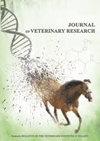Microbiological analysis of skin lesions of cod (Gadus morhua) from the southern part of the Baltic Sea
IF 1.3
3区 农林科学
Q2 VETERINARY SCIENCES
引用次数: 0
Abstract
Since the middle of the 1980s, severe skin disorders have been observed in Baltic cod (Gadus morhua) each year. Available data on the spectrum of bacteria isolated from the clinical cases being limited, and evaluation of the microbial background of fish skin lesions being useful, a bacteriological examination has been undertaken. A total of 1,381 cod were caught during two voyages of the Baltica research vessel in the Polish exclusive economic zone of the southern Baltic Sea. After an examination which found lesions in 164 of the fish, a microbiological analysis was performed to isolate bacteria from them. The collected strains were phenotyped and genotyped, and their antimicrobial resistance was analysed by minimum inhibitory concentration (MIC) techniques. Bacteriological examinations provided 850 isolates. The dominant microorganisms were mesophilic Aeromonas spp., Pseudomonas spp. and Shewanella baltica. Opportunistic bacteria potentially hazardous to human health were also isolated, e.g. Alcaligenes faecalis, Staphylococcus epidermidis, Stenotrophomonas maltophilia and Vibrio sp. The MIC analysis determined the highest number of bacteria to resist sulphamethoxazole and amoxicillin and clavulanic acid. Most of the collected bacteria were opportunistic pathogens for fish, widespread in the aquatic environment, and potentially threatening to humans.波罗的海南部鳕鱼皮肤损伤的微生物学分析
自 20 世纪 80 年代中期以来,波罗的海鳕鱼(Gadus morhua)每年都会出现严重的皮肤病。由于从临床病例中分离出的细菌谱系数据有限,而评估鱼类皮肤病变的微生物背景非常有用,因此我们进行了细菌学检查。 波罗的海号研究船在波罗的海南部波兰专属经济区进行了两次航行,共捕获了 1,381 条鳕鱼。检查发现其中 164 条鱼有病变,随后进行了微生物分析,从中分离出细菌。对收集到的菌株进行了表型和基因分型,并通过最小抑菌浓度 (MIC) 技术分析了它们的抗菌性。 细菌学检查提供了 850 个分离菌株。主要微生物为嗜中性气单胞菌属、假单胞菌属和巴氏雪旺菌。此外,还分离出了可能危害人类健康的机会性细菌,如粪钙化杆菌、表皮葡萄球菌、嗜麦芽气单胞菌和弧菌。MIC 分析表明,耐磺胺甲噁唑、阿莫西林和克拉维酸的细菌数量最多。 收集到的大多数细菌都是鱼类的机会性病原体,在水生环境中广泛存在,对人类有潜在威胁。
本文章由计算机程序翻译,如有差异,请以英文原文为准。
求助全文
约1分钟内获得全文
求助全文
来源期刊

Journal of Veterinary Research
Veterinary-General Veterinary
CiteScore
0.90
自引率
5.60%
发文量
58
审稿时长
18 weeks
期刊介绍:
Journal of Veterinary Research (formerly Bulletin of the Veterinary Institute in Pulawy) is a quarterly that publishes original papers, review articles and short communications on bacteriology, virology, parasitology, immunology, molecular biology, pathology, toxicology, pharmacology, and biochemistry. The main emphasis is, however, on infectious diseases of animals, food safety and public health, and clinical sciences.
 求助内容:
求助内容: 应助结果提醒方式:
应助结果提醒方式:


